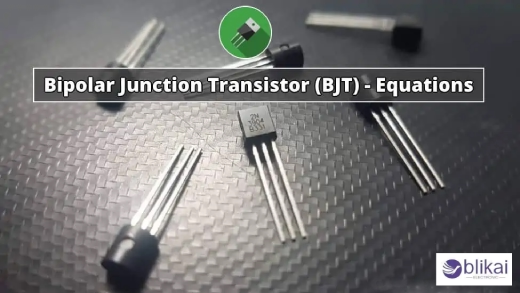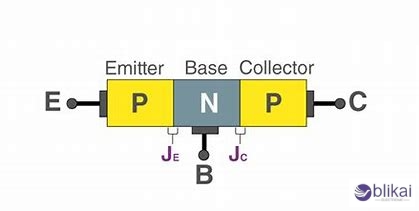Understanding Bipolar Junction Transistor (BJT): A Beginner's Guide
What is a Bipolar Junction Transistor (BJT)?
A bipolar junction transistor( BJT) is a directly junctioned electronic device generally applied in revision and switching circuits. It's composed of alternate layers formed by either P- type or N- type semiconductors and comprises three regions: the emitter, the base, and the collector. Those regions of a BJT form two p- n junctions through which the transistor controls the inflow of electrical current.

Types of BJTs: NPN and PNP
These two types of BJTs include NPN and PNP transistors. In NPN transistors, both the emitter and collector are n-type semiconductors, where the base is p-type. For a PNP transistor, the emitter and collector regions are p-type and base is n-type. The main difference here lies with respect to polarity and current direction accompanying the applied voltages. NPN transistors are commonly preferred due to the higher mobility of electrons, which provides them with faster switching capability and better performance in most of the applications.
Symbol representation in circuit diagrams
In circuit diagrams, BJTs are represented with specific symbols that indicate the type and structure. The NPN symbol is a circle with a small arrow showing the direction of the emitter current. In contrast to this, the PNP symbol has an arrow pointed toward the base. The collector and base are represented by lines connected to the circle with the emitter line containing the arrow. These symbols help engineers and technicians quickly distinguish the type and orientations of BJTs among complicated circuit layouts.
How Bipolar Junction Transistor (BJT) Work
Current flow in BJTs
BJTs operate based on the interaction between two closely spaced PN junctions. In an NPN transistor, current overflows from the collector to the emitter when a small current is applied to the base. This base current controls the larger collector- emitter current, allowing the transistor to amplify signals or act as a switch.
Regions of operation: active, cutoff, and saturation
BJTs have three central regions of operation:
- Active region: The transistor acts as an amplifier, with the collector-emitter current proportional to the base current.
- Cutoff region: The transistor is out, with minimum current inflow between the collector and emitter.
- Saturation region: The transistor is entirely on, with maximum current inflow between the collector and emitter.
Importance of biasing
Proper biasing is crucial for BJT operation. It sets the initial operating point, determining which region the transistor operates in. Correct biasing ensures the transistor functions as intended, whether as an amplifier or switch. Without proper biasing, the transistor may not respond to input signals or may operate inefficiently.
Key Components of Bipolar Junction Transistor (BJT)
Emitter: purpose and function
The emitter is a pivotal element of a Bipolar Junction Transistor( BJT). Its primary function is to emit or fit charge carriers into the base region. In an NPN transistor, the emitter releases electrons, while in a PNP transistor, it emits holes. The emitter is heavily unraveled to ensure a high attention of maturity charge carriers, enabling effective injection into the base.
Base: controlling the transistor
The base is the BJT's control element. It's a thin, smoothly unravel region squeezed between the emitter and collector. The base regulates the inflow of current through the transistor. A small change in the base current can significantly affect the collector current, giving the BJT its amplifying parcels. The base- emitter junction is forward- poisoned, while the base- collector junction is rear- prejudiced during regular operation.
Collector: output characteristics
The collector is the BJT's output terminal. Its primary role is to collect the charge carriers injected by the emitter and passed through the base. The collector is moderately doped and typically larger than the emitter. It's designed to handle advanced voltages and currents compared to the other regions. The collector- emitter voltage and current determine the transistor's affine characteristics, making it pivotal for colorful operations similar to modification and switching.

Applications of Bipolar Junction Transistor (BJT)
Amplification in audio circuits
BJTs excel in audio amplification, which is a cornerstone of many sound systems. In these circuits, BJTs boost weak audio signals to drive speakers or headphones. Their ability to handle small changes in input current makes them ideal for preserving sound quality while increasing volume.
Switching in digital circuits
In digital electronics, BJTs serve as efficient switches. They can rapidly transition between on and off states, making them crucial components in logic gates and memory devices. This quick-switching capability is fundamental to the operation of computers and other digital systems.
Voltage regulation
BJTs play a vital part in voltage regulation circuits, helping to maintain a constant affair voltage despite oscillations in input or load. This application is essential in power supplies for electronic devices, ensuring stable and reliable operation across varying conditions.
Signal processing
In signal processing applications, BJTs manipulate and condition various types of signals. They can be found in filters, mixers, and modulators, where they help shape and transform signals for communications systems, sensor interfaces, and other analog circuits.
Advantages and Disadvantages of Bipolar Junction Transistor (BJT)
High current gain
BJTs are renowned for their impressive current gain, also known as β (beta) or hFE. This characteristic allows a small base current to control a much larger collector current, making BJTs excellent amplifiers. The high current gain enables efficient signal amplification in various electronic applications, from audio systems to radio frequency circuits.
Temperature sensitivity
Though a number of advantages are presented by BJTs while temperature sensitivity serves as one of their limitations. The character of variable temperature may radically change for the heat gain and performance of a transistor so that its reliability aspect will be affected. Such a sensitivity factor is a very important point when designing a certain circuit, which most often leads to temperature compensation schemes for other components to maintain steady state conditions under various environmental conditions.
Comparison with other transistor types
BJTs have their own set of advantages and disadvantages when compared to other types of transistors. Unlike FETs, which are voltage-controlled devices, BJTs are current-controlled devices and, hence, more preferable for particular applications in many situations. Compared with the FETs, they have higher input linearity and transconductance, making them the active elements of choice for analog circuits. On the contrary, BJTs generally consume more power in addition to having a lower input impedance in comparison with FETs. Conversely, MOSFETs have shown their superiority in the digital realm because of their reduced power dissipation and a very high input impedance. These differences signify recognition for using BJTs in select applications.
Selecting the right Bipolar Junction Transistor (BJT)
Selecting the right BJT for your work involves carefully weighing your circuit requirements against the specifications of the transistor. Consider the maximum voltage and current ratings, as well as the gain and frequency response. Also consider the kind of package that the transistor will be in, as well as what other thermal characteristics you need to deal with to ensure that the transistor is treated right within your circuit design. By carefully analyzing the specifications of the datasheet and the parameters and curves within it, it will be possible to make a better choice of a BJT, something that will suit your work appropriately.
Troubleshooting BJT Circuits
Common issues in BJT circuits
When working with BJT circuits, several common issues can arise. One frequent problem is incorrect biasing, which can lead to distortion or complete failure of the circuit. Thermal runaway is another concern, especially in high-power applications, where increased temperature causes higher collector current, potentially damaging the transistor. Signal distortion can occur due to improper operating point selection or overloading of the input signal.
Testing BJTs with a multimeter
The multimeter serves as a useful instrument for troubleshooting circuits containing BJTs. Test a BJT by first establishing its connections: collector, base, and emitter as per its datasheet. With the multimeter, set it in the diode test mode to measure the junctions connecting base-emitter and base-collector in both forward and reverse directions. Both junctions of a good BJT should generally show low resistance one way and high resistance the other way. Resistance across the collector-emitter junction shall read high resistance in both directions.
Identifying faulty BJTs in a circuit
They can be set up in filters, mixers, and modulators, where they help shape and transfigure signals for dispatches systems, sensor interfaces, and other analog circuits. Measure voltages at each terminal and compare to expected values. An open or short-circuit junction can be indicative of a bad transistor. Remove the BJT from the circuit and check it separately using the multimeter method outlined above. Remember, other components in the circuit can also cause problems, and hence a systematic approach towards troubleshooting is important.
Related Articles
What is the BC547 Transistor? Its Features & Applications
IRF540N Transistor: Applications, Datasheet and Features
2N7000 Transistor: Applications, Features and Datasheet
Types of 547 Transistors:All Explained
How to Test ECU with Multimeter: Complete Guide
The Ultimate Guide to CR1220 Battery
Variable Capacitors: A Complete Guide
Difference Between Isolator and Circulator? [Guide]
How to Test a Varistor?(Complete Guide)
Flexible Sensor Complete Guide
Basic Knowledge of Electronic Parts:Complete Guide
Comprehensive Guide to Common Sensors
Embedded System : Complete Guide
What is an Integrated Circuit? Applications, Functions and Types (Guide)
Varieties of Monitor Cables: A Beginner's Guide










